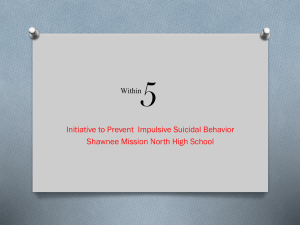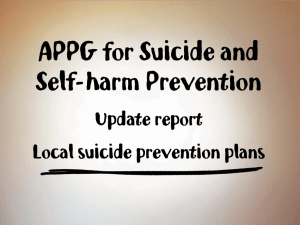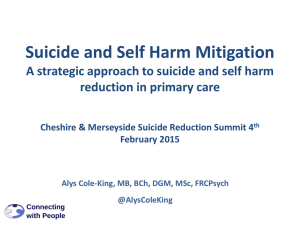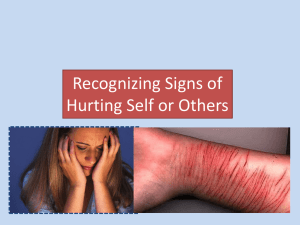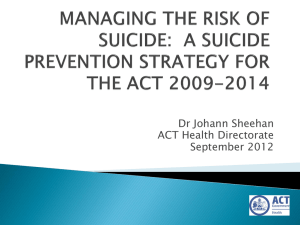Somerset Suicide Prevention Update 2014
advertisement
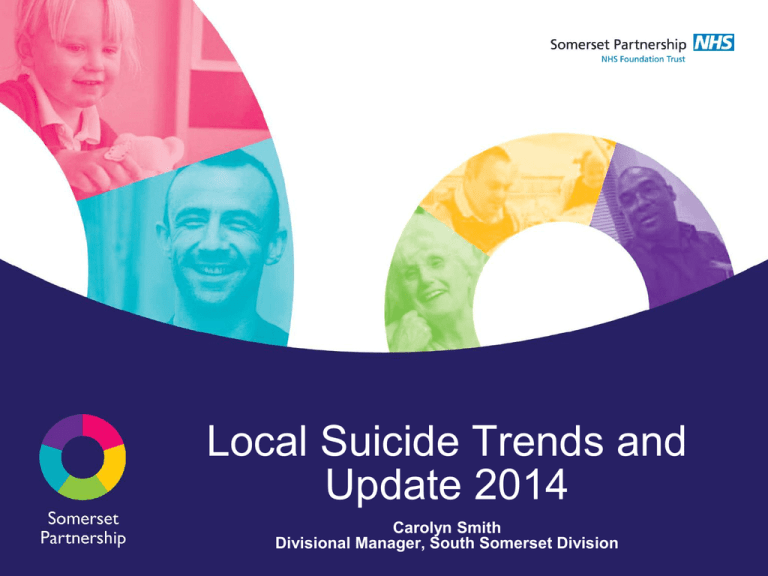
Local Suicide Trends and Update 2014 Carolyn Smith Divisional Manager, South Somerset Division Presentation Content • National Policy Context • Suicide Trends • Findings and recommendations from the National Confidential Inquiry (2014) • Suicide Prevention in Somerset • Somerset Suicide Prevention Advisory Group • Somerset Partnership Suicide Prevention Group • NHS England Zero Suicide Project National policy • Preventing Suicide in England: A crossgovernment outcomes strategy to save lives (2012) • Suicide prevention is not the sole responsibility of any one sector • One quarter of people who die from suicide have been in contact with specialist mental health services in the previous year • More can be achieved by collaborative working across government, local agencies and services • Local responsibility for coordinating and implementing work on suicide prevention (Healthy Lives, Healthy People, Our Strategy for Public Health in England, 2010) Policy Objectives • A reduction in the suicide rate in the general population in England • Better support for those bereaved or affected by suicide Six key areas for action • Reduce the risk of suicide in key high-risk groups • Tailor approaches to improve mental health in specific groups • Reduce access to the means of suicide • Provide better information and support to those bereaved or affected by suicide • Support the media in delivering sensitive approaches to suicide and suicidal behaviour • Support research, data collection and monitoring. High risk groups identified in the strategy • Young and middle-aged men • People in the care of mental health services, including inpatients • People with a history of self-harm • People in contact with the criminal justice system • Specific occupational groups, such as doctors, nurses, veterinary workers, farmers and agricultural workers. Tailored approach • Children and young people, including those who are vulnerable such as looked after children, care leavers and children and young people in the youth justice system; • Survivors of abuse or violence, including sexual abuse; • Veterans; • People living with long-term physical health conditions; • People with untreated depression; • People who are especially vulnerable due to social and economic circumstances; • People who misuse drugs or alcohol; • Lesbian, gay, bisexual and transgender people; and • Black, Asian and minority ethnic groups and asylum seekers. Suicide Trends A note about suicide rates… • Different figures from different sources; – Different parameters used, for example population and age; – Coding differences and changes; – Narrative verdicts; – Some NCI data about patients who have had contact with mental health services in the previous 12 months is produced from questionnaires sent to mental health services; – Different ways of reporting in NHS Trusts; • Some report suspected suicides as ‘suicide’ and others report these deaths as ‘unexpected deaths’. Suicide Rates: England • 78,170 suicides in England from 1996 to 2012; • 20,300 (26%) of which were patient suicides; • Patients defined as people who had been in contact with mental health services in the 12 months prior to their death; • Small reduction in the suicide rate from 2002 apart from slight increase in 2008; • 10.6 deaths per 100,000 general population in 2002; • 9.4 deaths per 100,000 general population in 2012; • Higher suicide rate per 100,00 of the general population in the rest of the UK: – 17.4 in Scotland – 15.4 in Northern Ireland – 12.4 in Wales • (NCI, 2014) Suicide rates per 100,000 by area 2010-2012, NCI (2014) • Ranges from 7.2 to 11.4 per 100,000 • • • • • • • • • Birmingham and the Black Country 7.2; London 7.7 – 8.3 Bristol, Somerset and South Gloucestershire 9.7; Bath, Gloucestershire, Swindon and Wiltshire 9.9; Merseyside 10.1; North Yorkshire and the Humber 10.7; Devon, Cornwall and Isles of Scilly 11.1; Greater Manchester 11.1 Lancashire 11.4 Somerset suicide rate: Public Health Outcomes Framework (2014) HSCIC 2010-12 Number of suicides or deaths following injury of undetermined intent (15+) Directly standardised rate (15+) Somerset 138 10.43 South West 1,529 11.62 England 13,209 10.09 HSCIC 2012 Number of suicides or deaths following injury of undetermined intent (15+) Directly standardised rate (15+) Somerset 38 8.5 South West 519 11.7 England 4,507 10.2 National Confidential Inquiry Findings (2014) • • • • Young people under 25 accounted for 10% of all suicides; Suicide rate for men is just over double the rate for women; Increase in male suicide rates for ages 45 to 64; 37% of those who died from suicide had not seen their GP in the previous year; • More likely to be male and younger than those who did seek GP support; • Rate of suicide for patients under Community Treatment Orders was 2.2 per 1,000 in 2009-2012, higher than the rate for all patients; – Patients are usually selected for CTOs on the basis of risk; • 54% of people had a history of drug and/or alcohol misuse. Findings: Patient Suicide, (NCI, 2014) • Little variation in the overall number of patient suicides over the past 10 years; • Significant reduction in deaths of people who are inpatients; • After the introduction of Crisis/Home Treatment Teams in 2004-6, deaths in the community increased; – 11% of suicides in Crisis Teams; • A downward trend appears to be emerging from 2009 for suicides in Crisis Teams; • Living alone is associated with suicide for patients under the care of Crisis Teams; – 47% of people who died lived alone; – 49% experienced adverse life events. Patient Suicide Numbers Patient suicides 1250 1123 1242 1307 1272 Inpatient suicides 165 Crisis (CRHT) team suicides 59 Year 2002 142 103 83 50 Estimate 156 223 185 149 Estimate 2006 2009 2011 2012 Findings: Inpatient Discharge, NCI (2014) • Increased risk of suicide for patients in first 3 months after discharge from in-patient services; –18% of all patient suicides; • Highest period of risk is first week after discharge; • Greatest risk is on day 2 following discharge; –20% of people who died within 7 days; • Short admissions under 7 days and adverse life events also linked to suicide in first 2 weeks after in-patient discharge; Findings: non-adherence and missed contacts, NCI (2014) • 14% patients had not adhered to their drug treatment in the month before their death; • 26% patients missed their final mental health service appointment before their death; • Non-adherence and missed contact are often linked; • 39% of patients were not receiving their planned treatment before their death; • Care Programme Approach (CPA) is protective (NCI, 2013). Findings: Suicide Method, NCI, (2014) 2500 2000 1500 General Population Patient Population 1000 500 0 Hanging & Self-poisoning Self strangulation Jumping & multiple injuries Most common drugs in selfpoisonings •Opiates •Tricyclic anti-depressants •Paracetamol/opiate compounds NCI Recommendations (2014) • Patient suicides – Address economic issues with patients. • Post-discharge suicide (from in-patient care) – Effective care planning addressing life events; – Early follow up; – Caution with short admissions; – Suicide within 3 days as a Never Event. • Crisis/Home Treatment Teams – Priority for suicide prevention; – Review suitability for certain patients. • Hanging – Media portrayals to be examined; What are we doing in Somerset? Somerset Suicide Prevention Advisory Group • Somerset Suicide Prevention Strategy • Coordinates and monitors suicide prevention activities • Multi-agency group Somerset Partnership Suicide Prevention Group • Strategic Plan • Mental health and community health services NHS England Zero Suicide in the South West project Advisory Group work streams • Systems in development for local suicide audit; – Aim to identify issues and provide focus for local action; • ASIST - suicide prevention skills training offered to frontline staff; – 2 new trainers; – 6 courses a year; • Samaritans sessions in the ED at Yeovil District Hospital once a week. Working to develop sessions at Musgrove Park Hospital; • 5000 copies of the Help At Hand leaflet distributed in the community including to street pastors; Work streams cont… • Suicide Bereavement Support Service; – Successful peer support group with 10 new joiners; – 30 people accessed support from Cruse Bereavement Support; – New leaflet of bereavement services produced; • Men’s health group established; – Planning a men’s health event and promoting the ‘Is your mate off his game’ leaflet; • New mental health toolkit developed with educational psychologists for schools; – Refreshing schools critical incident guidance to include more specific protocols around suicide; • Work with the Local Authority in relation to car parks, bridges, roads and high buildings; – Continue to monitor for suicide hotspots – a car park in Taunton was fenced off. Somerset Partnership Suicide Prevention Group Work Streams • Strategic Plan and Action Plan; • Recommendations from NCI and other learning being fed into Integration Phase 2, a whole service redesign project; • Assessment of policies, processes and practices against Safer Mental Health Services Toolkit; • Review of how learning from serious incidents is disseminated and embedded at all levels of the organisation; • Advanced risk training for professionally registered mental health staff is now a mandatory training requirement; • Suicide prevention awareness training for community health staff; • Front line operational group being established; – First project focuses on implementation of follow-up within 72 hours (NCI recommendation); • Service user and carer representatives joining the strategic group; Zero Suicide in the South West by 2018 • Henry Ford programme in Detroit • Provides mental health and substance misuse programmes; • Continuum of integrated services with 2 hospitals, 10 clinics and over 500 staff. • “Depression care program eliminates suicide” • Rate of suicide in patient population decreased by 75% in first four years of the programme; • 89 suicides per 100,000 to 22 per 100,000; • No suicides for two and a half years followed by very low rate. • Video conference with Edward Coffey; • Questions asked about validity of the data! How? • • • • • Consumer advisory panel helped design the program; Whole systems approach; Removal of barriers to access services; Education for families and carers; Protocols for three levels of risk for suicide, each with different interventions; • Different levels of access: drop-in, medication appointments, same day access, e-mail support, website; • Protocol for removing weapons from the home. Potential use for other means in Somerset; • Questionnaires at every contact to check well-being, understanding of treatment and satisfaction. Staff don’t proceed with any treatment/intervention until scores of 9 or above are achieved – ‘Perfect Care’. Reference: The National Confidential Inquiry into Suicide and Homicide by People with Mental Illness Annual Report 2014 University of Manchester nci@manchester.ac.uk Free Stay Alive App. Helpful advice and information for people at risk of suicide and people supporting them.




